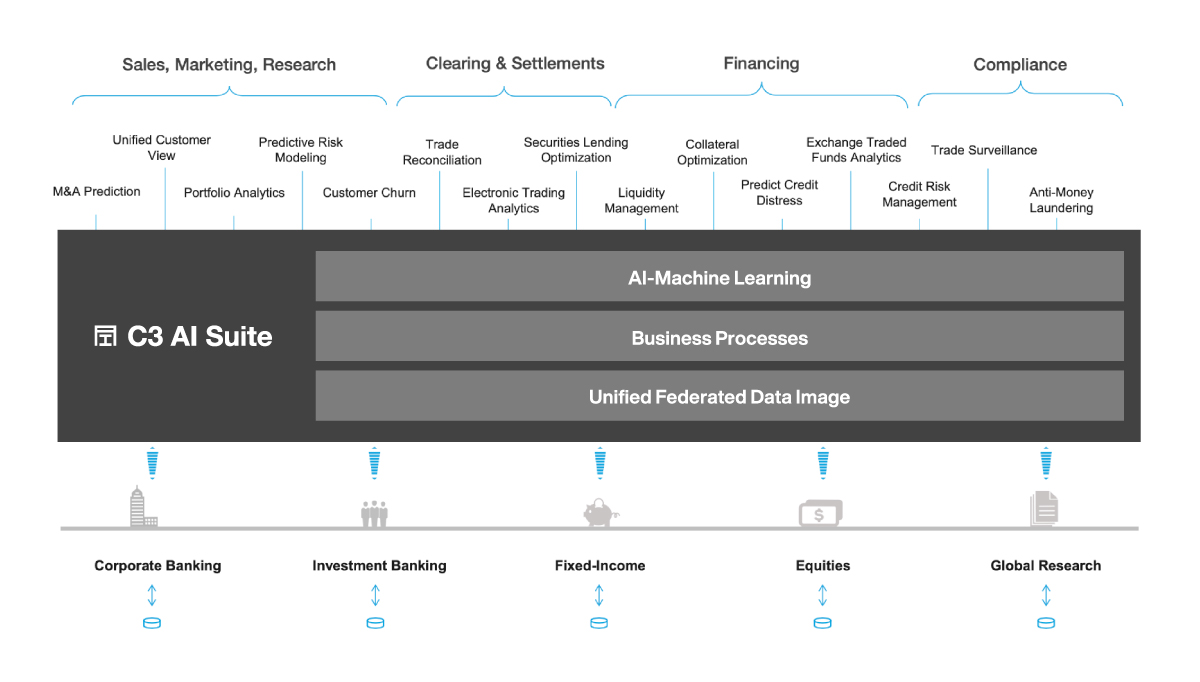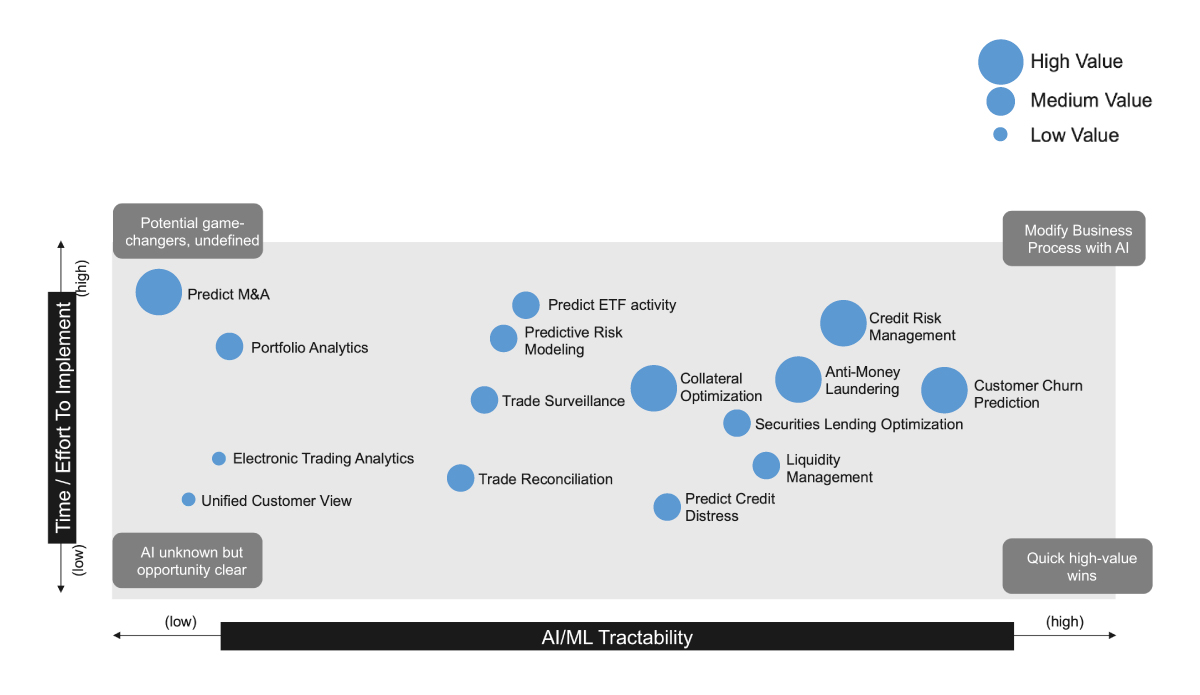- AI Software
- C3 AI Applications
- C3 AI Applications Overview
- C3 AI Anti-Money Laundering
- C3 AI Cash Management
- C3 AI CRM
- C3 AI Decision Advantage
- C3 AI Demand Forecasting
- C3 AI Energy Management
- C3 AI ESG
- C3 AI Intelligence Analysis
- C3 AI Inventory Optimization
- C3 AI Process Optimization
- C3 AI Production Schedule Optimization
- C3 AI Property Appraisal
- C3 AI Readiness
- C3 AI Reliability
- C3 AI Smart Lending
- C3 AI Sourcing Optimization
- C3 AI Supply Network Risk
- C3 AI Turnaround Optimization
- C3 AI Platform
- C3 Generative AI
- Get Started with a C3 AI Pilot
- Industries
- Customers
- Resources
- Generative AI
- Generative AI for Business
- C3 Generative AI: How Is It Unique?
- Reimagining the Enterprise with AI
- What To Consider When Using Generative AI
- Why Generative AI Is ‘Like the Internet Circa 1996’
- Can Generative AI’s Hallucination Problem be Overcome?
- Transforming Healthcare Operations with Generative AI
- Data Avalanche to Strategic Advantage: Generative AI in Supply Chains
- Supply Chains for a Dangerous World: ‘Flexible, Resilient, Powered by AI’
- LLMs Pose Major Security Risks, Serving As ‘Attack Vectors’
- C3 Generative AI: Getting the Most Out of Enterprise Data
- The Key to Generative AI Adoption: ‘Trusted, Reliable, Safe Answers’
- Generative AI in Healthcare: The Opportunity for Medical Device Manufacturers
- Generative AI in Healthcare: The End of Administrative Burdens for Workers
- Generative AI for the Department of Defense: The Power of Instant Insights
- What is Enterprise AI?
- Machine Learning
- Introduction
- What is Machine Learning?
- Tuning a Machine Learning Model
- Evaluating Model Performance
- Runtimes and Compute Requirements
- Selecting the Right AI/ML Problems
- Best Practices in Prototyping
- Best Practices in Ongoing Operations
- Building a Strong Team
- About the Author
- References
- Download eBook
- All Resources
- C3 AI Live
- Publications
- Customer Viewpoints
- Blog
- Glossary
- Developer Portal
- Generative AI
- News
- Company
- Contact Us
- Introduction
- What is Machine Learning?
- Tuning a Machine Learning Model
- Evaluating Model Performance
- Runtimes and Compute Requirements
- Selecting the Right AI/ML Problems
- Best Practices in Prototyping
- Problem Scope and Timeframes
- Cross-Functional Teams
- Getting Started by Visualizing Data
- Common Prototyping Problem – Information Leakage
- Common Prototyping Problem – Bias
- Pressure-Test Model Results by Visualizing Them
- Model the Impact to the Business Process
- Model Interpretability Is Critical to Driving Adoption
- Ensuring Algorithm Robustness
- Planning for Risk Reviews and Audits
- Best Practices in Ongoing Operations
- Building a Strong Team
- About the Author
- References
- Download e-Book
- Machine Learning Glossary
Selecting the Right AI/ML Problems
Use Case Prioritization
A crucial initial step in a digital transformation effort can be to perform a use case prioritization exercise to identify a portfolio of high-priority AI/ML problems appropriate for an enterprise, business unit, or division. Setting priorities for use cases involves thinking through all of the dimensions mentioned in this chapter, including problem tractability, economic value, and ethical considerations.
At C3 AI, we have reviewed hundreds of enterprise AI problems over the last decade. A typical first step involves a full value-chain exploration of high-potential AI/ML use cases. The following figure depicts an illustrative, high-level value chain map of AI use cases for a financial services company.

Figure 24: High-potential AI/ML use cases for a financial services company. Example from a C3 AI strategic workshop
After developing a case map, business leaders typically want to perform additional exploratory work in certain areas to further flesh out the most tractable and valuable use cases for their organizations.
Most organizations can conduct a deep-dive exploration and understanding of AI/ML use cases quite rapidly, without requiring a prolonged strategy phase. The leadership team usually already has the relevant business knowledge with the help of SMEs. At C3 AI, we have developed a playbook over the past decade that lets us rapidly identify a portfolio of high-potential AI/ML use cases through a series of screening and scoping exercises and workshops. The basic principles are quite simple.
First, we ask business leaders and their management teams to fill out a template of the top business problems that they think could benefit from the application of AI. This activity is performed as pre-work before more detailed and in-depth workshops and discussions take place. The high-potential use cases outlined in the figure above can serve as inspiration for such an exercise. But we have found that, in most cases, business leaders and SMEs have already given significant thought to areas that can benefit from the application of AI/ML. The following figure shows an example of a pre-work template for use case identification and prioritization.
Use Case Overview (describe in simple terms what value an AI solution would bring to the business):
- Identify early warning signals of clients who are likely to move their investments to another financial services company to enable proactive and timely engagement of those clients and take proactive action to intercept churn.
Figure 25: Illustrative template to be filled out as pre-work, ahead of use case prioritization workshops
This pre-work activity is then followed by one or more use case prioritization workshops. The workshops can take many forms. One of the most productive formats involves presentations made by individual managers proposing their candidate AI/ML use cases to a leadership steering committee. In such a workshop format, individual managers explain the reasons why they consider their use case to be high-potential and a top priority.
This format accomplishes two objectives simultaneously. First, it ensures that the business requirements and value around a specific use case have been thought through well and peer-reviewed by both leadership and the AI/ML steering committee. Second, this format ensures that the business has bought into the opportunity’s value and benefits. All too often, enterprise leaders delegate AI/ML initiatives to digital or IT teams, stepping away from direct involvement. Ultimately, however, the entire business needs to incorporate AI/ML technology as part of their day-to-day operations in order to unlock value. Incorporating AI/ML involves business process change and challenging change management activities. A format in which the business actively asks for investment, early in the process, ensures that there is strong buy-in from business managers, plus interest and alignment in wholeheartedly implementing the AI/ML technology as part of daily business operations.
Following one or more use case presentation and discussion workshops, most businesses can assemble a portfolio of AI/ML initiatives to prioritize, resource, and put into production to unlock significant business and operational benefits to the full enterprise.
The following figure shows an illustrative example of a portfolio of high-potential AI/ML use cases for a business unit within a financial services company. Time-to-value, tractability, and the actual economic value are plotted on the chart. Business unit leaders can use this portfolio analysis to plan out their AI/ML transformation roadmap. In the example below, for instance, they may start with AI projects for customer churn or anti-money-laundering – efforts that may require a “medium” effort or time to implement, but are very tractable and have high economic value. These initial projects then can fund additional efforts as part of an enterprise AI transformation roadmap.

Figure 26: Illustrative portfolio of AI/ML use cases for a business unit at a financial services company
Once the initial use cases are prioritized, enterprises can then prototype those use cases and scale them into production. The next chapter focuses on best practices in managing AI/ML prototyping efforts.
